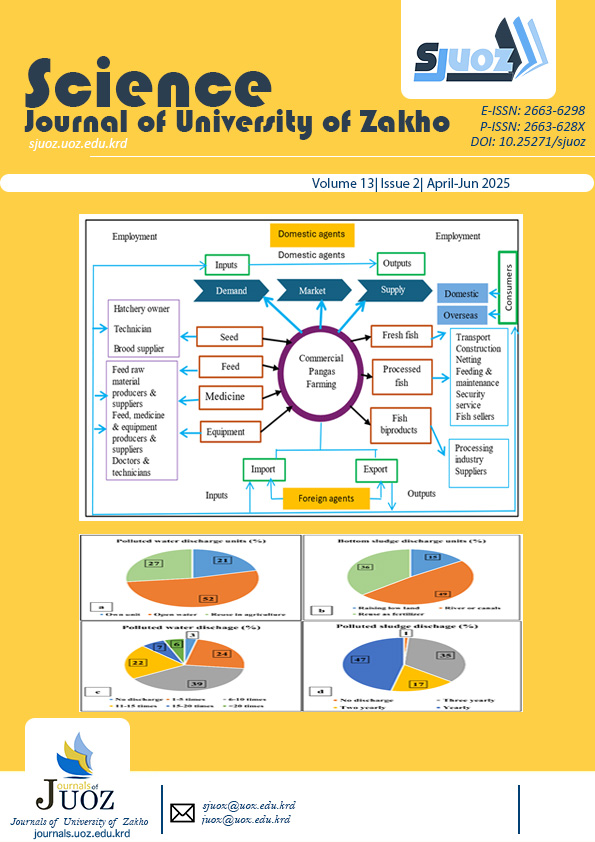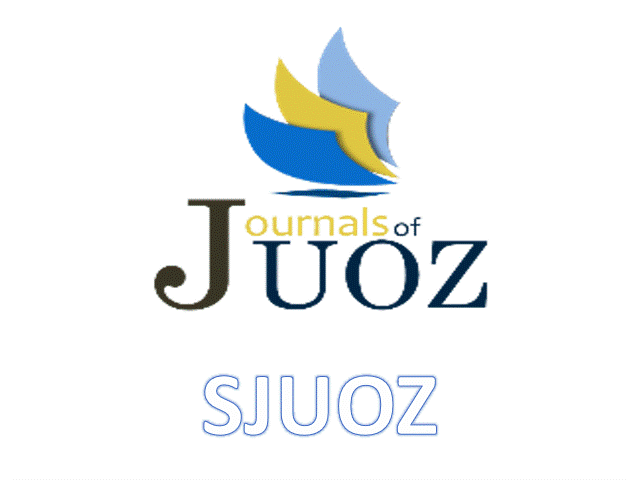ANTIBACTERIAL ACTIVITY OF SILVER NANOPARTICLES SYNTHESIZED BY HYDROTHERMAL TECHNIQUE
DOI:
https://doi.org/10.25271/sjuoz.2025.13.2.1476Keywords:
Silver Nanoparticles, Hydrothermal Technique, Polyvinylpyrrolidone Stabilizer, Size Control, Antibacterial ActivityAbstract
In this work, Ag NPs were synthesized via a hydrothermal method using silver nitrate (AgNO3) as precursor material. The impact of PVP concentration on the particle size distribution and surface morphology of Ag NPs in the hydrothermal reaction was studied. The obtained Ag NPs were characterized by UV–Vis, XRD, FESEM, and FTIR measurements. The calculated values of Eg from the absorption peaks of the UV/Vis- spectra were found to be increased from 1.70 eV to 1.87 eV with increasing the concentration of PVP from 0.2 mol/L to 0.5 mol/L. XRD measurements revealed that the Ag NPs are highly crystalline. The FESEM observation results indicated that the optimized synthesized Ag NPs are spherical with an average size of 140 nm. The FTIR results confirmed the Ag NPs formation with presence of several functional groups in Ag NP and pure PVP. The study evaluated the antibacterial activity of Ag NPs based on the diameter of the inhibition zone in the agar well diffusion method. The results indicated that the characteristics and antibacterial activity of Ag NPs could be optimized by altering the concentration of PVP used as a stabilizer. The Ag NPs synthesized without the addition of PVP showed antibacterial activity on both gram-negative bacterium Escherichia coli (11 to 12) mm and gram-positive bacterium Staphylococcus aureus (12 to 13) mm, meanwhile with using PVP, there is no inhibitory activity towards gram-negative bacteria but showed antibacterial activity on gram-positive (25) mm. The stability of Ag NPs has been investigated by measuring the absorption spectrum of the PVP-Ag NPs, which was found to be stable for nearly 3 months. Synthesis of stable Ag NPs is necessary for later use in the required application.
Downloads
References
REFERENCES
Abbas, R., Luo, J., Qi, X., Naz, A., Khan, I. A., Liu, H., Yu, S., & Wei, J. (2024). Silver nanoparticles: Synthesis, structure, properties and applications. Nanomaterials, 14(17), 1425. https://doi.org/https://doi.org/10.3390/nano14171425
Ahmad, A. A. (2022). Solid State Synthesis of Silver Nanoparticles Using Violuric Acid as a Novel Reducing Agent. Science Journal of University of Zakho, 10(4), 193-196. https://doi.org/https://doi.org/10.25271/sjuoz.2022.10.4.1021
Altammar, K. A. (2023). A review on nanoparticles: characteristics, synthesis, applications, and challenges. Frontiers in microbiology, 14, 1155622. https://doi.org/https://doi.org/10.3389/fmicb.2023.1155622
Bamiduro, F., William, N., Hondow, N., Milne, S., Nelson, A., & Drummond-Brydson, R. (2018). Hydrothermal Synthesis of Silver Nanoparticles for High Throughput Biosensing Applications. MRS Advances, 3(15-16), 861-866.
https://doi.org/ https://doi.org/10.1557/adv.2018.197
Bhatia, D., Mittal, A., & Malik, D. K. (2016). Antimicrobial activity of PVP coated silver nanoparticles synthesized by Lysinibacillus varians. 3 Biotech, 6, 1-8. https://doi.org/https://doi.org/10.1007/s13205-016-0514-7
Cheng, Y., Wang, M., Fang, C., Wei, Y., Chen, J., & Zhang, J. (2021). Variability and improvement of optical and antimicrobial performances for CQDs/mesoporous SiO2/Ag NPs composites via in situ synthesis. Green Processing and Synthesis, 10(1), 403-411. https://doi.org/https://doi.org/10.1515/gps-2021-0035
Dakal, T. C., Kumar, A., Majumdar, R. S., & Yadav, V. (2016). Mechanistic basis of antimicrobial actions of silver nanoparticles. Frontiers in microbiology, 7, 1831. https://doi.org/https://doi.org/10.3389/fmicb.2016.01831
Ding, X., Kan, C., Mo, B., Ke, S., Cong, B., Xu, L., & Zhu, J. (2012). Synthesis of polyhedral Ag nanostructures by a PVP-assisted hydrothermal method. Journal of Nanoparticle Research, 14, 1-9. https://doi.org/https://doi.org/10.1007/s11051-012-1000-8
Duman, H., Eker, F., Akdaşçi, E., Witkowska, A. M., Bechelany, M., & Karav, S. (2024). Silver nanoparticles: A comprehensive review of synthesis methods and chemical and physical properties. Nanomaterials, 14(18), 1527. https://doi.org/ https://doi.org/10.3390/nano14181527
Eker, F., Duman, H., Akdaşçi, E., Bolat, E., Sarıtaş, S., Karav, S., & Witkowska, A. M. (2024). A comprehensive review of nanoparticles: from classification to application and toxicity. Molecules, 29(15), 3482. https://doi.org/ https://doi.org/10.3390/molecules29153482
El Amri, N., & Roger, K. (2020). Polyvinylpyrrolidone (PVP) impurities drastically impact the outcome of nanoparticle syntheses. Journal of Colloid and Interface Science, 576, 435-443. https://doi.org/https://doi.org/10.1016/j.jcis.2020.04.113
Esmael, M. M. (2024). ENHANCED SYNTHESIS OF NiO NANO FILM THROUGH SOL-GEL DIP COATING METHOD: INVESTIGATION THE IMPACT OF LASER IRRADIATION. Science Journal of University of Zakho, 12(4), 436-441. https://doi.org/ https://doi.org/10.25271/sjuoz.2024.12.4.1308
Feng, S.-H., & Li, G.-H. (2017). Hydrothermal and solvothermal syntheses. In Modern inorganic synthetic chemistry (pp. 73-104). Elsevier. https://doi.org/https://doi.org/10.1016/B978-0-444-63591-4.00004-5
Ferreira, A. M., Vikulina, A., Loughlin, M., & Volodkin, D. (2023). How similar is the antibacterial activity of silver nanoparticles coated with different capping agents? RSC advances, 13(16), 10542-10555. https://doi.org/DOI: 10.1039/D3RA00917C
Gao, M., Sun, L., Wang, Z., & Zhao, Y. (2013). Controlled synthesis of Ag nanoparticles with different morphologies and their antibacterial properties. Materials Science and Engineering: C, 33(1), 397-404. https://doi.org/https://doi.org/10.1016/j.msec.2012.09.005
Ghadiri, M., Hallajzadeh, J., Akhghari, Z., Nikkhah, E., & Othman, H. (2023). Green synthesis and antibacterial effects of silver nanoparticles on novel activated carbon. Iran J. Chem. Chem. Eng.
Gharibshahi, L., Saion, E., Gharibshahi, E., Shaari, A. H., & Matori, K. A. (2017). Influence of Poly (vinylpyrrolidone) concentration on properties of silver nanoparticles manufactured by modified thermal treatment method. PLoS One, 12(10), e0186094. https://doi.org/https://doi.org/10.1371/journal.pone.0186094
Ivlieva, A., Petritskaya, E., Rogatkin, D., Yushin, N., Grozdov, D., Vergel, K., & Zinicovscaia, I. (2022). Does nanosilver have a pronounced toxic effect on humans? Applied Sciences, 12(7), 3476. https://doi.org/ https://doi.org/10.3390/app12073476
Jalal, V. J. (2024). Structural and optical properties of polymer blend nanocomposites based on PVP/PVA incorporated AgNO3. Journal of Physics Communications, 8(5), 055004. https://doi.org/DOI 10.1088/2399-6528/ad4e97
Khan, I., Saeed, K., & Khan, I. (2019). Nanoparticles: Properties, applications and toxicities. Arabian journal of chemistry, 12(7), 908-931. https://doi.org/https://doi.org/10.1016/j.arabjc.2017.05.011
Khizir, H. A., & Abbas, T. A.-H. (2021). Hydrothermal growth and controllable synthesis of flower-shaped TiO 2 nanorods on FTO coated glass. Journal of Sol-Gel Science and Technology, 98, 487-496. https://doi.org/https://doi.org/10.1007/s10971-021-05531-z
Koczkur, K. M., Mourdikoudis, S., Polavarapu, L., & Skrabalak, S. E. (2015). Polyvinylpyrrolidone (PVP) in nanoparticle synthesis. Dalton transactions, 44(41), 17883-17905. https://doi.org/ https://doi.org/10.1039/C5DT02964C
Li, J., Wu, Q., & Wu, J. (2016). Synthesis of nanoparticles via solvothermal and hydrothermal methods. 12. In: Springer international publishing Switzerland.
Liu, H., Wang, S., Li, Z., Zhuo, R., Zhao, J., Duan, Y., Liu, L., & Yang, J. (2024). Experimental study on the preparation of monodisperse nano-silver by hydrothermal synthesis. Materials Chemistry and Physics, 314, 128902. https://doi.org/https://doi.org/10.1016/j.matchemphys.2024.128902
Mirzaei, A., Janghorban, K., Hashemi, B., Bonyani, M., Leonardi, S. G., & Neri, G. (2017). Characterization and optical studies of PVP-capped silver nanoparticles. Journal of Nanostructure in Chemistry, 7, 37-46. https://doi.org/https://doi.org/10.1007/s40097-016-0212-3
Mohammed, J. H., & Salih, N. A. M. (2022). Synthesis and characterization of some new nitrones derivatives and screening their biological activities. Science Journal of University of Zakho, 10(4), 268-273. https://doi.org/ https://doi.org/10.25271/sjuoz.2022.10.4.1096
More, P. R., Pandit, S., Filippis, A. D., Franci, G., Mijakovic, I., & Galdiero, M. (2023). Silver nanoparticles: bactericidal and mechanistic approach against drug resistant pathogens. Microorganisms, 11(2), 369. https://doi.org/https://doi.org/10.3390/microorganisms11020369
Neto, F. N. S., Morais, L. A., Gorup, L. F., Ribeiro, L. S., Martins, T. J., Hosida, T. Y., Francatto, P., Barbosa, D. B., Camargo, E. R., & Delbem, A. C. (2023). Facile synthesis of PVP-Coated silver nanoparticles and evaluation of their physicochemical, antimicrobial and toxic activity. Colloids and Interfaces, 7(4), 66. https://doi.org/https://doi.org/10.3390/colloids7040066
Obaidellah, J., & Ahmed, S. A. (2023). CHARACTERIZATION OF SYNTHESIZED SILVER NANOPARTICLES USING LEPIDIUM SATIVUM PLANT. Science Journal of University of Zakho, 11(4), 548–556-548–556. https://doi.org/https://doi.org/10.25271/sjuoz.2023.11.4.1174
Oliveira, A. E. F., Pereira, A. C., de Resende, M. A. C., & Ferreira, L. F. (2022). Synthesis of a silver nanoparticle ink for fabrication of reference electrodes. Talanta Open, 5, 100085. https://doi.org/https://doi.org/10.1016/j.talo.2022.100085
Perumal, R., Casale, S., De Stefano, L., & Spadavecchia, J. (2017). Synthesis and characterization of Ag-Protoporphyrin nano structures using mixed co-polymer method. Frontiers in Laboratory Medicine, 1(2), 49-54. https://doi.org/https://doi.org/10.1016/j.flm.2017.05.002
Slewa, L. H., Abbas, T. A., & Ahmed, N. M. (2019). Hydrothermal and solvothermal synthesis of nanorods and 3D (micro/nano) V 2 O 5 on macro PSi substrate for pH-EGFET sensors. Journal of Materials Science: Materials in Electronics, 30, 11193-11207. https://doi.org/
https://doi.org/10.1007/s10854-019-01465-z
Slewa, L. H., Gozeh, B. A., Ismael, D. S., FaqeAbdulla, N. Q., & Othman, H. O. (2024). Antibacterial and Antifungal Activity of Ag-NPs Colloids Prepared by a Hydrothermal Reaction in Green Synthesized CQD. BioNanoScience, 1-17. https://doi.org/https://doi.org/10.1007/s12668-024-01486-x
Tang, S., & Zheng, J. (2018). Antibacterial activity of silver nanoparticles: structural effects. Advanced healthcare materials, 7(13), 1701503. https://doi.org/ https://doi.org/10.1002/adhm.201701503
Tooklang, P., Audtarat, S., Chaisen, K., Thepsiri, J., Chingsungnoen, A., Jittabut, P., & Dasri, T. (2024). Functionalization of silver nanoparticles coating cotton fabrics through hydrothermal synthesis for improved antimicrobial properties. Nano Express, 5(2), 025009. https://doi.org/DOI 10.1088/2632-959X/ad437b
Van Viet, P., Sang, T. T., Bich, N. H. N., & Thi, C. M. (2018). An improved green synthesis method and Escherichia coli antibacterial activity of silver nanoparticles. Journal of Photochemistry and Photobiology B: Biology, 182, 108-114. https://doi.org/https://doi.org/10.1016/j.jphotobiol.2018.04.002
Wang, J., Yu, Y., Zhao, X., Sun, J., Wang, Y., & Zhu, H. (2023). A review on the size-dependent bulking, vibration and, wave propagation of nanostructures. Journal of Physics: Condensed Matter, 35(29), 293001. https://doi.org/DOI 10.1088/1361-648X/acc62b
Yaqoob, A. A., Umar, K., & Ibrahim, M. N. M. (2020). Silver nanoparticles: various methods of synthesis, size affecting factors and their potential applications–a review. Applied Nanoscience, 10(5), 1369-1378. https://doi.org/https://doi.org/10.1007/s13204-020-01318-w
Yatem, A. A., & Rammoo, M. S. (2023). Nanostructured Silver Thin Film: Using Successive Ionic Layer Adsorption and Reduction Method. Science Journal of University of Zakho, 11(1), 73-77. https://doi.org/ https://doi.org/10.25271/sjuoz.2023.11.1.1017
Zein, R., Alghoraibi, I., Soukkarieh, C., Ismail, M. T., & Alahmad, A. (2022). Influence of polyvinylpyrrolidone concentration on properties and anti-bacterial activity of green synthesized silver nanoparticles. Micromachines, 13(5), 777. https://doi.org/ https://doi.org/10.3390/mi13050777
Published
How to Cite
Issue
Section
License
Copyright (c) 2025 Shireen Taily Abduljabbar, Tariq Abdul-Hameed Abbas

This work is licensed under a Creative Commons Attribution 4.0 International License.
Authors who publish with this journal agree to the following terms:
- Authors retain copyright and grant the journal right of first publication with the work simultaneously licensed under a Creative Commons Attribution License [CC BY-NC-SA 4.0] that allows others to share the work with an acknowledgment of the work's authorship and initial publication in this journal.
- Authors are able to enter into separate, additional contractual arrangements for the non-exclusive distribution of the journal's published version of the work, with an acknowledgment of its initial publication in this journal.
- Authors are permitted and encouraged to post their work online.








